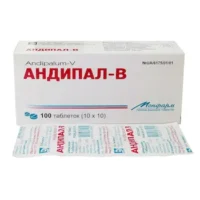Description
Ascopar (Acetylsalicylic Acid) Tablets №10
Composition
Each tablet contains: Acetylsalicylic acid 100mg.
Mechanism of Action
Acetylsalicylic acid, the active ingredient in Ascopar tablets, acts as an analgesic, antipyretic, and anti-inflammatory agent. It inhibits the enzyme cyclooxygenase, thereby reducing the production of prostaglandins which are involved in the inflammatory process.
Pharmacological Properties
Ascopar tablets exhibit analgesic, antipyretic, and anti-inflammatory properties. The drug is rapidly absorbed in the gastrointestinal tract and metabolized in the liver to its active form.
Indications for Use
Ascopar tablets are indicated for pain relief, fever reduction, and inflammation management in conditions such as headache, muscle aches, dental pain, menstrual cramps, and minor arthritis.
Contraindications
Do not use Ascopar tablets if you:
- Are allergic to acetylsalicylic acid or other NSAIDs.
- Have a history of gastrointestinal bleeding.
- Are pregnant or breastfeeding without medical advice.
Side Effects
Common side effects of Ascopar tablets may include gastrointestinal irritation, ulcers, bleeding, and allergic reactions. Discontinue use and seek medical attention if any adverse reactions occur.
Usage Instructions
Adults: Take 1 tablet orally every 4 to 6 hours as needed, not exceeding 4 tablets in 24 hours. Swallow the tablet whole with a full glass of water. Do not crush or chew the tablet. Consult a healthcare professional for proper usage.
Benefits Compared to Analogues
Ascopar tablets offer the advantage of a well-established safety profile and proven efficacy in pain relief and inflammation management compared to other NSAIDs. The lower risk of cardiovascular side effects further distinguishes Ascopar in certain patient populations.
Suitable Patient Groups
Ascopar tablets are suitable for use in adults and adolescents over 12 years old. Caution should be exercised in the elderly population and those with a history of peptic ulcer disease or renal impairment.
Storage and Shelf Life
Store Ascopar tablets in a cool, dry place away from direct sunlight. Keep the medication out of reach of children. Check the expiration date on the packaging and do not use the tablets beyond the stated shelf life.
Packaging Description
Ascopar tablets are available in blister packs of 10 tablets each. The packaging is designed to protect the tablets from moisture and ensure their integrity until use.
Clinical Evidence and Proven Effectiveness
Acetylsalicylic acid, the active ingredient in Ascopar tablets, has been extensively studied and proven effective in various clinical trials. Clinical studies have shown the efficacy of Ascopar in providing rapid and sustained relief from pain and inflammation. Consult your healthcare provider for more information on the clinical evidence supporting the use of Ascopar tablets.





